










When the Woolsey Fire tore through Malibu in 2018, it felt like the end of the world as we knew it. But half of our town survived, scarred, yes, but still standing. However, in reality, it was the beginning of the end.
This January, the Palisades Fire came for the rest. In a single, searing sweep, the other half of Malibu, its history, our hangouts, our heart...was gone.
Entire stretches of Pacific Coast Highway reduced to ash. What Woolsey spared, Palisades Fire obliterated.
We didn’t just lose homes and landmarks, we lost the soul of a place once defined by a rare, unshakable magic.
Since founding 90265 Magazine in 2013, I’ve spent years chronicling Malibu’s iconic lifestyle and the people whose character and grit gave this town its heartbeat. The memories will live on in those pages, and in our memories.
This year has been an awakening for me, one as jarring and irreversible as the fires themselves. Maybe it’s the chaos of the times. Maybe it’s the profound personal changes I didn’t see coming, the kind that shake you down to your core.
Either way, my trajectory has shifted. The way I see the world, the way I move through it. It’s a different world now.
What I know is this: loss will gut you, but it will also strip away what doesn’t matter. And in that raw, unfiltered place, you find the truth.
That truth is this: we were lucky enough to live in our own Shangri-La, to collect beautiful memories before devastation stripped Malibu of its soul.
Now, a new chapter begins, not just for me, but for Cali Mag as well.
For years, I wrestled with its identity through waves of global and local upheaval. But now the path is clear, and with clarity comes change - and this time, it’s welcome.
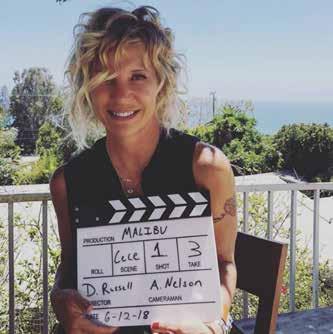
FOUNDER, EDITOR IN CHIEF












The Palisades Fire stripped MALIBU of much of its charm, erasing historical landmarks and gutting the small business scene wth the fivemonth shut down of PCH. Longtime residents, worn down by loss and soaring costs, fled the area, leaving behind a community struggling to reclaim its once-iconic allure.

BROOKE BURKE graces the cover of Cali Mag in a moment of full-circle transformation, an icon of the early 2000s who’s now leading a global wellness movement rooted in authenticity, intention, and feminine power. From her signature BB Body app to luxurious wellness retreats with Yogando, Brooke is redefining what it means to live well at every age.

In this issue, Cali Mag dives into the unapologetically raw rise of LA musician TYLER STONE, from banging out beats on garage drum kit gifted by his dad, to surviving industry fizzles, personal loss, and a rock-n-roll spiral, only to reemerge with a country-pop edge, heavyweight collaborators, and a laser-focused mission to fill stdiums. Fueled by family, faith, and a healthy dose of grit, Stone’s story isn’t just about making music, it’s about turning chaos into anthems.
TRIBUTE PROJECT COUTURE is the brainchild of celebrity stylist DANI STONE, a rock-n-roll–inspired fashion atelier that brought couture flair to concert merch. Born from Stone’s love for live music and her West L.A. upbringing on the Sunset Strip.



TONIA AREY’S role evolved from a determined local environmental advocate with PROTECT CALABASAS into a bold candidate for Los Angeles County Supervisor. What began as a fight to protect her community has grown into a countywide mission, as she now channels that same resolve into a campaign centered on strengthening public safety, building true environmental resilience, and putting people before politics.

ALEX VILLANUEVA, a 35-year veteran of the Los Angeles County Sheriff’s Department and the historic reformer who in 2018 became the first to unseat a sitting sheriff in more than a century, is now mounting a comeback in the 2026 race. He’s officially declared his candidacy to reclaim the sheriff’s badge, pledging to “Rescue. Rebuild. Restore.” - bringing steady, proven leadership back to the nation’s largest sheriff’s department.

The REBECCA GROSSMAN case has become one of the most polarizing cases in Los Angeles County. Critical evidence was overlooked or mishandled, eyewitness accounts, and the involvement of multiple vehicles, dismissed. The case was politicized at the height of the pandemic, with prosecutors leaning into public outrage while the media amplified a one-sided narrative. The trial became a lightning rod for emotion and politics, raising serious questions about due process and equal justice in Los Angeles County.
Producer DAVID GOLDBLUM lost his home, along with countless neighbors, in Malibu’s Big Rock community on January 7, 2025. Out of the ashes came BIG ROCK BURNING, a documentary born from devastation, determined to uncover the truth behind the catastrophe while giving those who losteverything a reason to hope again.
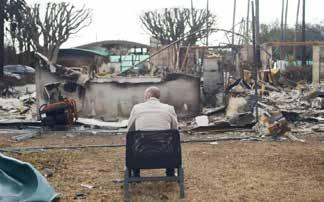



Cali Mag is proud to welcome MITCH STONE, celebrity hair stylist, accomplished photographer, and all-around creative powerhouse, as our new Director of Photography.
For more than two decades, Mitch has been the go-to name in Hollywood for crafting unforgettable looks and capturing equally unforgettable images.
His career has taken him from the heat of the red carpet to the intimacy of editorial shoots, styling and photographing some of the most iconic faces in entertainment for film, television, high-fashion campaigns, and glossy magazine covers.
Mitch’s artistry is defined by a signature blend of effortless glamour, impeccable lighting, and a fierce commitment to individuality. It’s a sensibility honed not just behind the camera, but also in the styling chair, giving him an unparalleled dual perspective on beauty and image-making.
His eye for detail transforms a moment into a story, whether he’s shooting a luxury beauty campaign, an intimate portrait, or a behind-thescenes video for his A-list clients.

Photography, for Mitch, has always been personal. Inspired by his father, he learned the craft of shooting and darkroom printing in his childhood home, developing an instinct for storytelling through imagery that still guides him today. His work, rich with authenticity, emotion, and elegance, has graced the pages of Vogue, Vanity Fair, Elle, and Harper’s Bazaar, cementing his status as a visionary in both beauty and photography.
Now, as Cali Mag’s Director of Photography, Mitch will bring his unique blend of Hollywood polish and California soul to our pages, capturing the people, places, and moments that define the Golden State.
One frame, and one story, at a time.
mitchstonestudio.com
Instagram: @mitchstoneofficial

BROOKE BURKE ISN’T SLOWING DOWN, SHE’S LEVELING UP.


Don’t expect Brooke Burke’s journey to wellness to be filtered through the usual aesthetic clichés, because she is building something deeper.
Through her digital app, curated retreats with Yogando, and newly refined nutritional line in partnership with Power Life, Burke is spearheading a movement rooted in presence, powe, and purpose.
Her signature 90-day challenge, Strong Together, isn’t about six-packs and selfies, it’s about reclaiming your strength from the inside out. “At this stage in my life, stepping into my power means honoring the full scope of my journey, my wisdom, my scars, my voice,” Burke tells Cali Mag. And that voice? It’s become a rallying cry for women seeking not just physical transformation, but emotional renewal and authentic community. Her app is built on the principle of “mindful fitness,” where movement is married to breath, intention, and self-love. It’s a refreshing alternative to the performative grind of traditional workouts, one that’s as much about longevity as it is about a sculpted core.
That ethos carries into her global retreat experiences with Yogando, where luxury meets soul work. “The transformation I witness isprofound,” Burke says. “Women come to remember who they are beyond the labels. They return home with clarity and confidence.” These retreats are more than a break from reality, they’re a return to it.
Once known for lighting up television screens as the host of Wild On! and later as a
Dancing with the Stars champion, Burke has gracefully evolved into a powerhouse wellness entrepreneur,and founder of the transformative Brooke Burke Body brand.
The same intention fuels the evolution of her supplement line, Longevity, now rebranded as Superfood Daily Blend under Power Life. “I created it because I couldn’t find a clean, plant-based formula that met my standards,” she explains. “Now we’ve made it even better, more fiber, more iron, less sugar, no soy.


“At this stage in my life, stepping into my power means honoring the full scope of my journey, my wisdom, my scars, my voice,”







It’s designed for women at every age and stage.” Her mornings begin with a protein-rich smoothie that includes Power Life protein and superfood blend, proving that fueling the body can, and should, be both functional and delicious.
Burke’s devotion to wellness is holistic. She embraces a 17/7 intermittent fasting schedule, follows an anti-inflammatory diet, and skips snacking in favor of colorful, protein-packed meals. But nutrition, she insists, isn’t just about physical fuel, it’s about emotional resilience. “Food is medicine,” she says. “What we eat affects our mood, our energy, our ability to show up for life.”
And show up, she does. As a mother of four, Burke says motherhood remains her most sacred role, and the root of her wellness philosophy. “I want to model strength, compassion, and self-love for my children,” she shares. “But I’ve also learned that I can’t pour from an empty cup.”



“I want to model strength, compassion, and self-love for my children... But I’ve also learned that I can’t pour from an empty cup.”

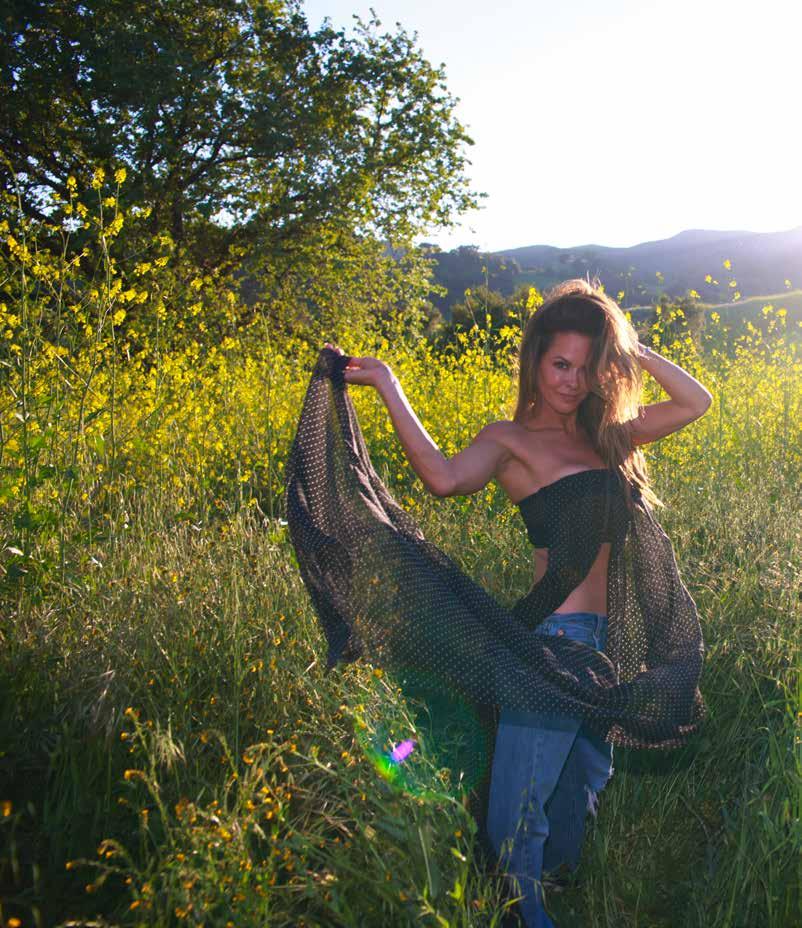
“Just a moment in nature to rewild, remember what home feels like, and reimagine what a new season of rebirth in Malibu will bring.”

Throughbreathwork, a practice that transformed her relationship to stress and emotional balance, Burke guides others to reconnect with themselves in a world that constantly demands their attention. Her own life-altering moment came through surviving cancer, a wake-up call that reordered her priorities around gratitude, presence, and joy. “It taught me to embrace imperfection, to live fully, and to let go of the noise,” she reflects.
Now with nearly four million followers and a booming digital wellness brand, Burke is focused on authenticity, not algorithms. “Staying grounded while growing is the challenge,” she admits. “But hearing from women whose lives have changed because of this work? That’s everything.”
As for what’s next? Expect more live classes, deeper collaborations, and expanded retreat offerings. But Brooke Burke’s true north remains the same: to empower everyBODY to feel strong, connected, and ageless, no matter where they are on the journey.
If she could whisper one piece of wisdom to her younger self, it would be this: “Trust yourself. Stay true. Ask your heart what it needs, and listen. That’s the real power.”
And just like that, Brooke Burke continues to lead not with a spotlight, but with a torch, lighting the way for women everywhere to step boldly into their own.
Hair
| Rain charvet Make up | Marylin Lee Stylist | Isabelle Sabel style
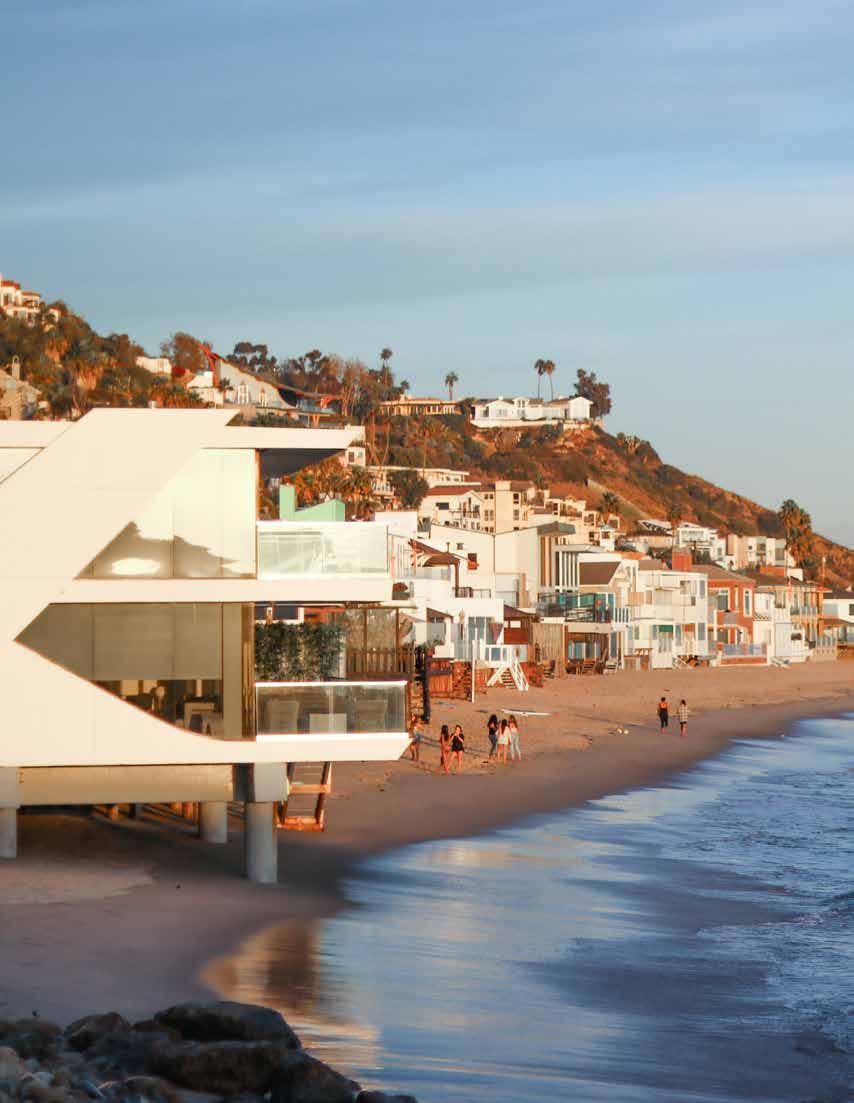
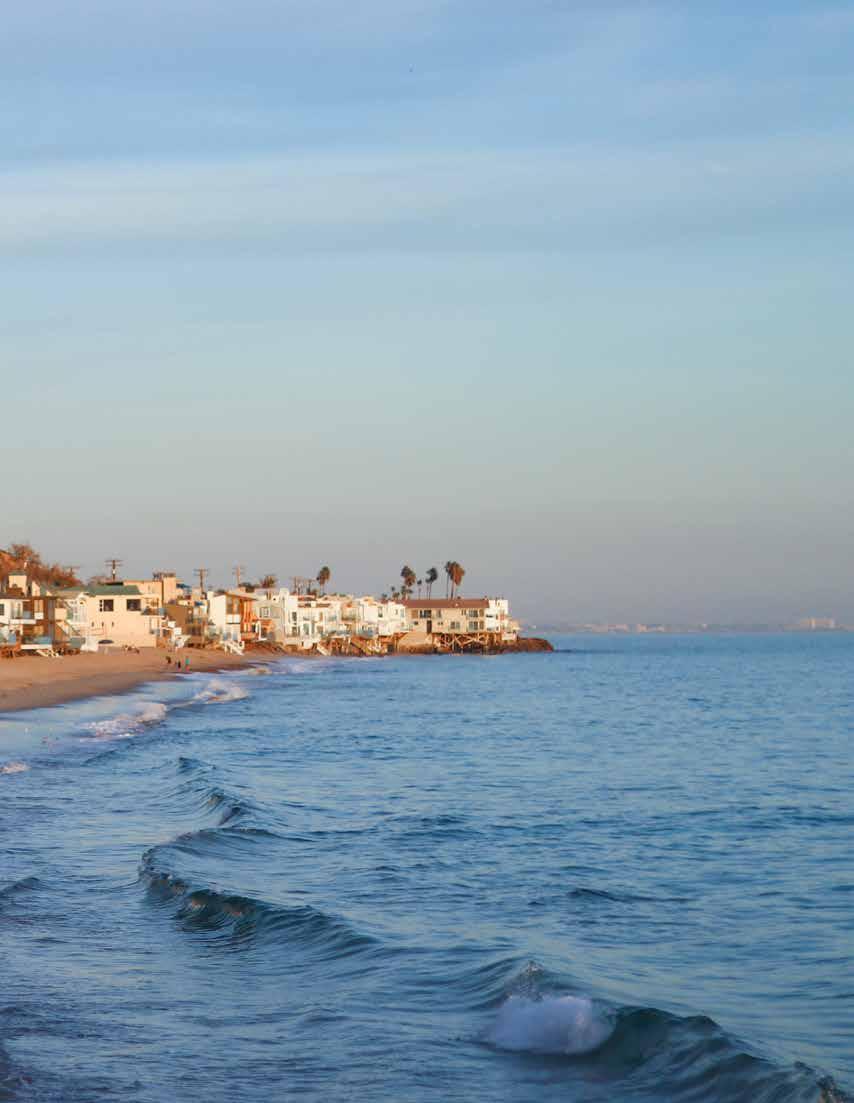

By Cece Woods, Editor in Chief

Malibuisn’t just a zip code, it’s a lifestyle...or at least it was.
Not one, but two devastating wildfires in just seven years have gutted the soul of this once-iconic enclave, its utopian existence gone for good.
In January 2025, the Palisades Fire tore through like a wrecking ball, delivering the fatal blow to the very heart of our coastal community.
The flames torched history, leveled character, and turned some of Malibu’s historical landmarks and beloved hangouts into ash.
What’s was left just smoke and seawater. Charred remains of Malibu history. It was a gut punch to the community watched its identity go up in flames. Finishing off what the Woolsey Fire started in 2018.
The Palisades Fire wasn’t just a wildfire, it was a cultural extinction event.
And it didn’t have to be.



Malibu’s soul took its first devastating hit on November 9, 2018, when the Woolsey Fire tore through the canyons in a matter of hours causing the most damage in Western Malibu.
The flames were merciless, but the deeper wound came after the smoke began to clear. As if surviving one of the most catastrophic wildfires in California history wasn’t enough, residents were dealt another, even more bitter truth: help wasn’t coming.
The day after the historic firestorm, LA County fire engines sat parked at Zuma Beach, ordered to stand down while homes that dodged the first wave of flames went up in smoke.
Barricades kept out food, water, and even critical medical supplies.

Malibu had always thrived on a sense of community and connection, and in the days after Woolsey, that spirit was tested in a way no one could have imagined. The fire didn’t just take homes, it stripped away the illusion that the public safety resources we counted on would be there when it mattered most. We were literally left to fend for ourselves.

November 9th, 2018, the Woolsey Fire rages in the backgroundof the Zuma Ridge Trailhead.
The Woolsey fire scorched nearly 100,000 acres and destroyed more than 1,600 structures, revealed not just the fury of nature, but also the devastating failure of leadership and emergency preparedness at every level.
In search of answers, Malibu resident Paul Taublieb reached out to me to collaborate on documenting and investigating this fire. Taublieb spoke directly to Malibu’s top officials, including Mayor Rick Mullen, who also happened to be a high-ranking L.A. County Fire Department captain, and City Manager Reva Feldman.
What he uncovered was a disturbing mixture of political deflection and bureaucratic paralysis.
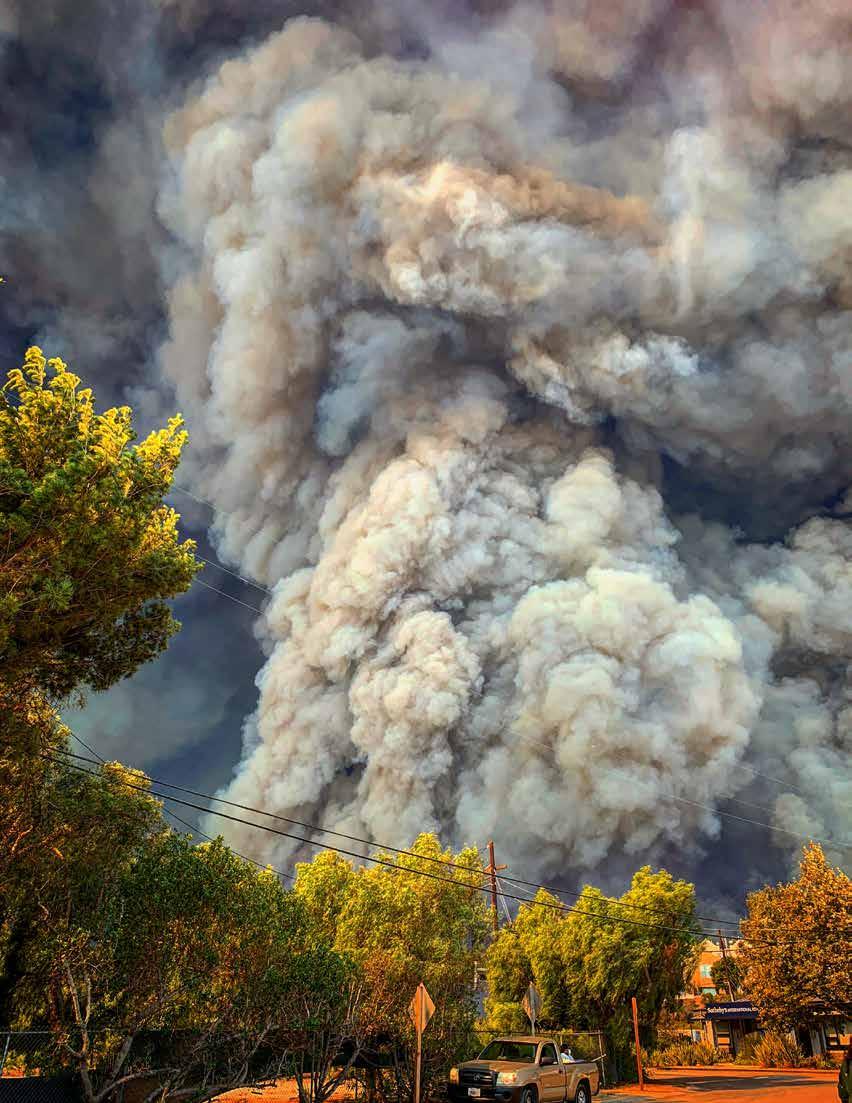

Mullen, in multiple interviews, dismissed concerns by insisting the fire was simply too large and too fast to fight, calling it unprecedented in scale and speed. He praised the response as “great,” while simultaneously admitting there were things they “learned” that could be improved next time, a contradiction that left many residents furious. When pressed on the total absence of local firefighting efforts, Mullen shifted blame to the county.
In the aftermath of the Woolsey Fire, the anger toward Malibu City Hall had a clear focal point: City Manager Reva Feldman. As The Local Malibu reported, Feldman’s response wasn’t just inadequate, it was infuriating.
While residents were scrambling to smuggle in food, water, and medicine past barricades, Feldman was laser-focused on “reopening the city” rather than getting aid to the people still trapped inside it.
Her lack of urgency and tone-deaf priorities lit a firestorm of outrage that spread almost as fast as Woolsey itself. Public meetings turned into shouting matches. Longtime residents, many of whom had just lost everything, were openly calling for her resignation, demanding accountability from a leader who seemed more interested in playing politics than protecting lives.
Perhaps the most damning detail came from a city insider who spoke to Taublieb anonymously. That official described the evacuation routes as a “highway of death,” referencing the chaos on PCH as tens of thousands tried to flee with no coordinated traffic control. They also questioned whether the people inside the city’s fire stations were even certified firefighters, a chilling thought given how many homes were left to burn unchecked. That same official did not mince words about who was ultimately responsible: “Any problems are her responsibility,” they said of Feldman.
Fire trucks stood idle as embers consumed homes that had been spared in the firestorm just the day before.

The failures extended far beyond logistical mistakes. They were failures of leadership, communication, and integrity. As residents watched their homes burn, they also witnessed a city structure crumble under the weight of its own denial. Instead of being protected by the officials they had trusted, and paid, to act in a crisis, they were left with barricades, silence, and excuses.
Taublieb’s account isn’t just a timeline of incompetence; it was a warning. What happened during the Woolsey Fire wasn’t just a natural disaster, it was a man-made failure of epic proportions. And as subsequent fires like the Palisades and Eaton catastrophes have shown, it may not have been an isolated one. The chilling implication is that what unfolded in Malibu in November 2018 was not just a tragedy, it was a preview of what was to come.

If the Woolsey Fire was a wake-up call, the Palisades Fire made it clear that n0 one will answer when the next disaster strikes

Ifthe Woolsey Fire was a wake-up call, the Palisades Fire made it clear that no one will answer when the next disaster strikes.
Long before the Palisades Fire roared through Malibu in January 2025, Aaron T. Jones, CEO of International Protective Service, Inc. (IPS) and founder of its elite Aviation Division, was sounding the alarm.
This wasn’t theory for Jones; during the 2018 Woolsey Fire, IPS boots on the ground were already in the fight, assisting overwhelmed first responders when needed, securing properties, and providing on-theground intelligence when official channels were crippled.
Fast forward to May, 2024, Jones addressed local officials at the Malibu State of the City event. He didn’t just warn those in attendance about the next disaster, he came armed with proof that his team was armed with state of the art technology and additional resources to protect residents from the next disaster. He gave a stern warning


to officials to prepare now. It wasn’t about IF the next disaster woud strike, it was WHEN.
Jones handed Malibu leadership the opportunity to learn more about a fully operational wildfire detection and rapid-response plan, complete with Sikorsky helicopters, thermal-imaging drones, and surveillance tech most government agencies only dream about. The response? Crickets.
“They didn’t think lightning would strike twice, but it did,” Jones said, referencing the city’s



refusal to take wildfire readiness seriously after Woolsey scorched nearly 100,000 acres, destroyed 1,600 structures, and forced almost 300,000 people from their homes. Since then, CalFire data shows a 30% increase in annual wildfires and a 47% spike in “mega fires” across Southern California. Peak fire season now stretches nearly half the year, yet Malibu officials still treat every blaze like an unpredictable anomaly instead of an inevitability.

Malibu wasn’t just at risk, it was under siege.
“This isn’t about politics,” Jones said afterward. “It’s about public safety. And if you’re in a leadership position, you better start leading - or step aside.”

When the Palisades Fire hit om Januar 7th, 2025, it was too late. In just days, it scorched over 23,000 acres, destroyed nearly 7,000 structures, and killed 12 people, surpassing Woolsey’s destruction in lives lost and structural annihilation. The very same officials who had brushed Jones off were now blowing up his phone as if IPS were their personal 911.


Rosenthal Winery Tasting room on PCH in Malibu, (photo#3) a destination for locals and tourists alike was another casualty of the Palisades Fire. The winery has since opened a new “Vineyard Experience” tasting room at their Malibu estate.
The Palisades Fire may not have caused the same physical destruction as Woolsey, but its impact was deeply psychological. It confirmed what many had feared since 2018: that despite public statements, press conferences, and promises of reform, Malibu remained unprepared. The same breakdown in coordination between city, county, and emergency agencies persisted. The same disconnect between leadership and lived experience resurfaced.
Together, these two events paint a sobering picture, not just of natural disaster, but of institutional failure. Malibu has endured fire, loss, and disruption. But more than anything, it has endured the consequences of a system that still struggles to put people ahead of politics, and prevention ahead of public relations.
“This isn’t about politics,” Jones said afterward. “It’s about public safety. And if you’re in a leadership position, you better start leading - or step aside.”
Now, as Malibu’s cultural scars deepen, so do the economic ones—revealed most starkly by investors circling the coast. Los Angeles Magazine reports that a mysterious foreign investor has quietly spent $65 million purchasing nine oceanfront lots along Pacific Coast Highway that were burned in the January 2025 Palisades Fire, an area where 340 homes were destroyed. This acquisition, reportedly made with little resistance, underscores the merciless calculus of real estate speculation in tragedy zones.


Reports indicate this buyer specifically targeted beachfront parcels; many owners, still reeling from the devastation or overwhelmed by the rebuilding process, were more willing to sell. The rebuild timeline, estimated at 12 to 24 months for permits, makes holding these lots a long-term play, banking on a spike in value once the coastline is rebuilt.
Empty beachfront lots are already commanding millions, one 6,200-square-foot parcel with direct beach access is currently listed at $2.75 million, despite having no structure. The desirability of Malibu land, even in the face of wildfire risk and insurance obstacles, remainsattractive to investors and developers.
The irony is stark: the same fires that stole Malibu’s iconic establishments are now unlocking vast speculative opportunities, transforming loss into raw land assets for wealthy entrepeneurs, even as the local community continues to mourn and rebuild.
One thing these new landowners will never experience is the Shangri-la Malibu once was, and likely will never be again.
Follow continuing coverage on the Palisades Fire aftermath on our sister publication Malibu Daily News.
malibudailynews.com

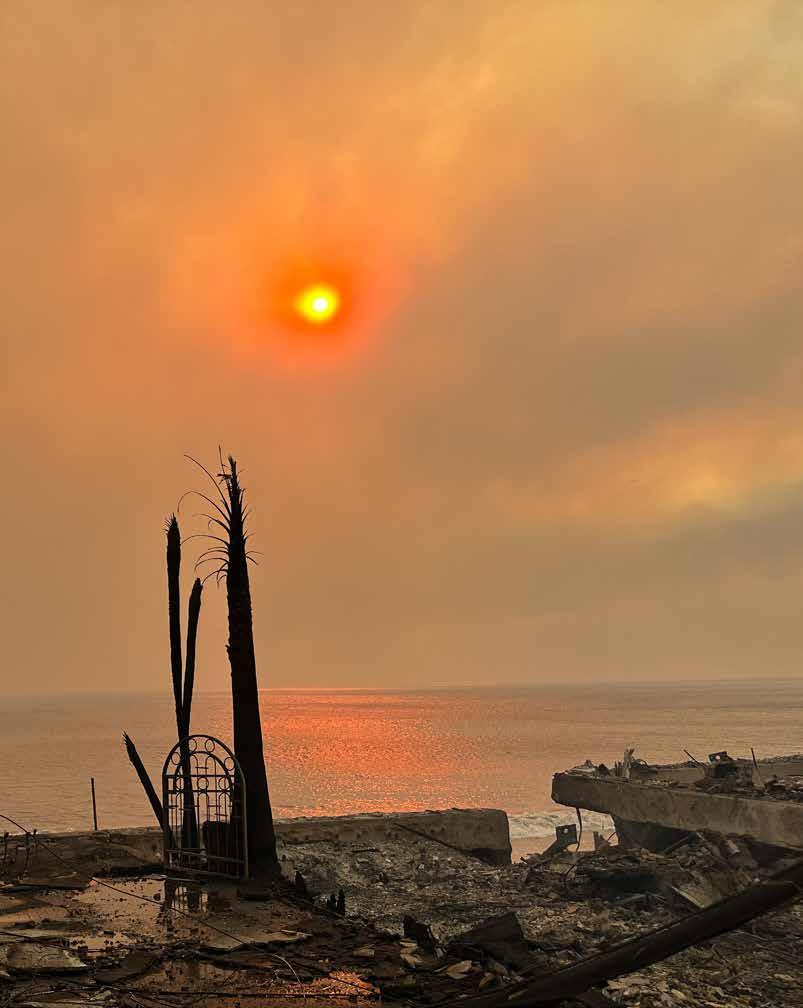


When the Palisades Fire roared into Malibu’s Big Rock neighborhood, it wasn’t just another wildfire. It was one of America’s worst, a night when emergency vehicles never came, evacuation routes turned into gauntlets of flames, and survival hinged on instinct.
Official orders kept firefighters at bay, leaving residents to choose: stay and fight or flee through walls of fire.
Some picked up garden hoses, battling back flames with nothing more than grit and desperation. Others drove blind through smoke, trusting the road ahead would still be there. In those hours, neighbors became each other’s lifelines, the kind of moments that define a community long after the smoke clears.
That’s the heartbeat of Big Rock Burning, a 30-minute documentary that pulls viewers directly into the heat, fear, and fierce will to survive. Produced by Julie Parker Benello (American Factory, Athlete A), James Costa (The Dating Game, Welcome to Chechnya), and guided by the powerhouse executive producing team of Mark Hamill (Star Wars, The Life of Chuck) and Bryan Fogel (Icarus, The Dissident), the film isn’t just about loss, it’s about what rises from it.
For producer/director DAVID GOLDBLUM, the project is deeply personal. As a resident who lost his own home that night, Goldblum brings an unflinching eye to the devastation and an intimate understanding of the human resilience it inspired. Through his Conscious Contact Entertainment banner, Goldblum has built a career on impact-driven stories, from the criminal justice drama Grassland (Executive Produced by Common) to the sex industry doc Sell/Buy/Date (Executive Produced by Meryl Streep), and most recently, Uvalde Mom, which premiered at SXSW. His commitment to telling stories that matter recently earned him a three-film producing deal with Village Roadshow Pictures.
Malibu audiences will get a first look before the rest of the world. On Friday, August 29th, the Malibu Film Society will host an exclusive sneak preview at Malibu City Hall. The screening will precede the film’s 1-week theatrical run in Los Angeles starting September 12.
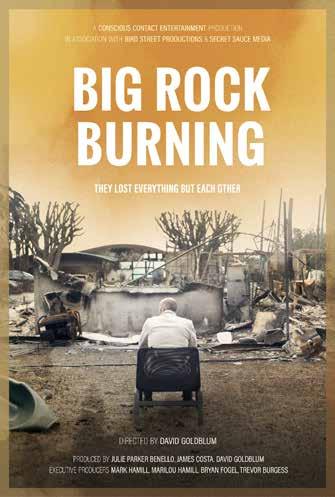
Big Rock Burning isn’t just a documentary, it’s a love letter to a neighborhood that refused to be erased, a cinematic reminder that while fire can take almost everything, it can’t burn away the human spirit. FOLLOW ON INSTAGRAM: @davidgoldblum @bigrockburning







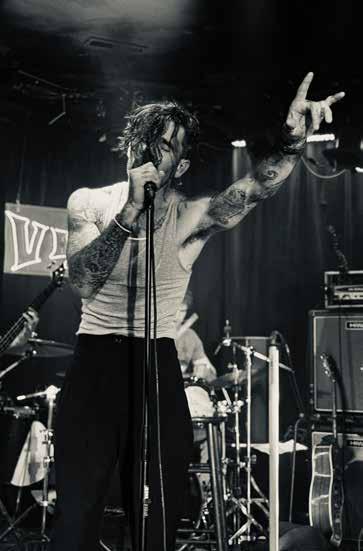

TylerStone’s journey to becoming one of LA’s most magnetic indie-pop acts didn’t start under the spotlight. it started in a garage, on a drum kit gifted by a dad who couldn’t resist handing over the noise problem to Tyler’s mom and stepdad. “Best part was, I was living with my mom at the time,” Stone laughs. “So my dad got to give his kid, who couldn’t really play yet, a drum set, and keep his own garage nice and quiet.”
Music was always in the air. His “Pops” surrounded him with friends like Perry Farrell and Stephen Perkins from Jane’s Addiction before Tyler even knew those names meant rock royalty. By the time he was singing over cover songs at highschool hangouts, the seed was planted: this was the life. “I always knew I’d be playing in front of thousands. It was just a matter of when.”
The day after graduation, Stone went straight to Hollywood, landing a session at the legendary Village Studios in Santa Monica. Fate stepped in when bassist Troy Spino, moonlighting with the band Wicker, recruited him. Before long, they were signed, flirting with Sony and Universal, doing mini-tours, and even starring in a Canadian reality show. But, like many promising acts, the spark fizzled.
What followed was the darker part of the story, the “drinking and being a loser” era, as Stone puts it with disarming bluntness. A few run-ins with the law, a creative drought, and the tragic motorcycle accident that took his stepfather, a legendary Hollywood stuntman who had raised him since he was three, left him gutted. “It wrecked part of our family,” Stone says. “But I cherish the 30 years I had with him. He gave me the strength to never give up.”
Two and a half years ago, Stone decided it was now or never. He flew to North Carolina, started recording a country-pop project, and immediately felt the momentum shift. Back in LA, he linked up with childhood friend Andrew Haas. the producer behind artists like Teddy Swims, Thomas Rhett, and P!nk. Together, they crafted Stone’s debut single Southern California and an EP that’s about to drop, complete with a music video and a string of future releases in the works.
If you ask Stone, music isn’t just a career. It’s an obsession. A calling. The thing he’d be doing whether it made him millions or cost him every dime he had. His purpose is twofold: to be a devoted father to Nova, Boston, and Beau, and to move audiences the way music has moved him through every high, low, and messy middle.
Now, with spins on The SoCal Sound (88.5 FM), collaborations with heavy-hitting producers, and a hustle that doesn’t quit, Tyler Stone is ready for the leap from local favorite to stadium headliner. “I’m just at the beginning,” he grins. “And that’s what really excites me. I will be one of your future favorites.”
As Stone puts it, “God is great all the time. All the time, God is great.”




On July 4, 2025, the Point Dume community came together for its 26th Annual 4th of July
Parade & Picnic, a vibrant tradition that’s been thriving since the late 1980s in Point Dume, Malibu.
Remarkably, the parade pushed on just six months after the devastating Palisades Fire, a testament to the community’s resilience and spirit.
The festivities featured a spirited parade on Point Dume, followed by family-friendly fun, food, and games at Malibu Elementary.
Highlights included horses and decorated vehicles, like golf carts draped with “FREEDOM” banners and motorcycles waving American flags, along with activities such as bubble play, fitness challenges, and a pop-up photo booth courtesy of MES PTA.
The community’s support was evident, PDCSD board member Chase Hirt who captured the event visually, local groups like CERT Malibu, Malibu VOP, and Station 71 Fire Dept, and generous sponsors including The Malibu Project, Cart Service USA, CrossFit Malibu, and others for making the celebration possible.

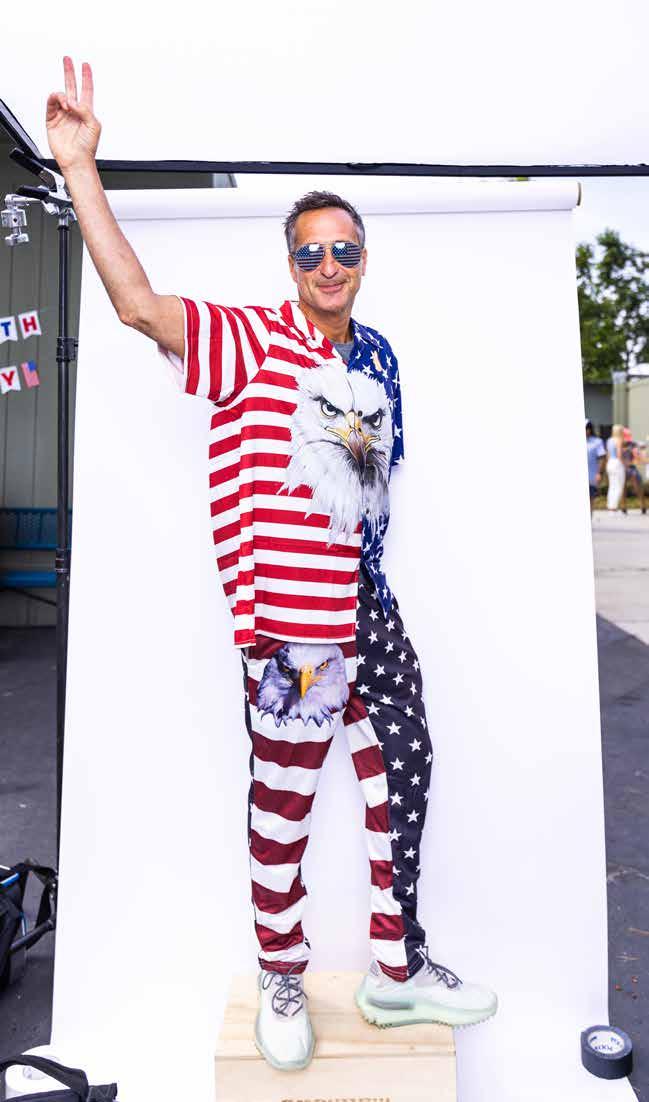






Volunteers and organizers include:





ESPERANZA - Esperanza
Cocina de la Playa, located at 309 Manhattan Beach Blvd., Manhattan Beach, CA 90266, is a vibrant Mexican restaurant offering an elevated take on Sonoran-inspired cuisine. The spot blends fresh seafood dishes like ceviche, enchiladas, and Pacific prawns with a curated, playful selection of tequila, mezcal, and craft cocktails.
309 Manhattan Beach Blvd. Manhattan Beach, CA 90266 @esperanzamanhattanbeach
SLOOPY’S - Sloopy’s Beach Café has been a beloved local staple for over 40 years. The café is celebrated for its commitment to fresh ingredients, sustainable seafood, and all-natural meats, crafting made-toorder meals that range from hearty burgers to unique salads and buttermilk pancakes 3416 Highland Avenue, Manhattan Beach, CA 90266 @sloopys_cafe
LOVE & SALT - Love & Salt puts a fresh spin on Italian-inspired cuisine infused with Southern California soul. Founded by Sylvie Gabriele in the former Café Pierre space, the restaurant follows a simple yet powerful philosophy: “food needs only two ingredients to be great.”
317 Manhattan Beach Blvd, Manhattan Beach, CA 90266 @loveandsaltla




Photography by Sefra Escobar
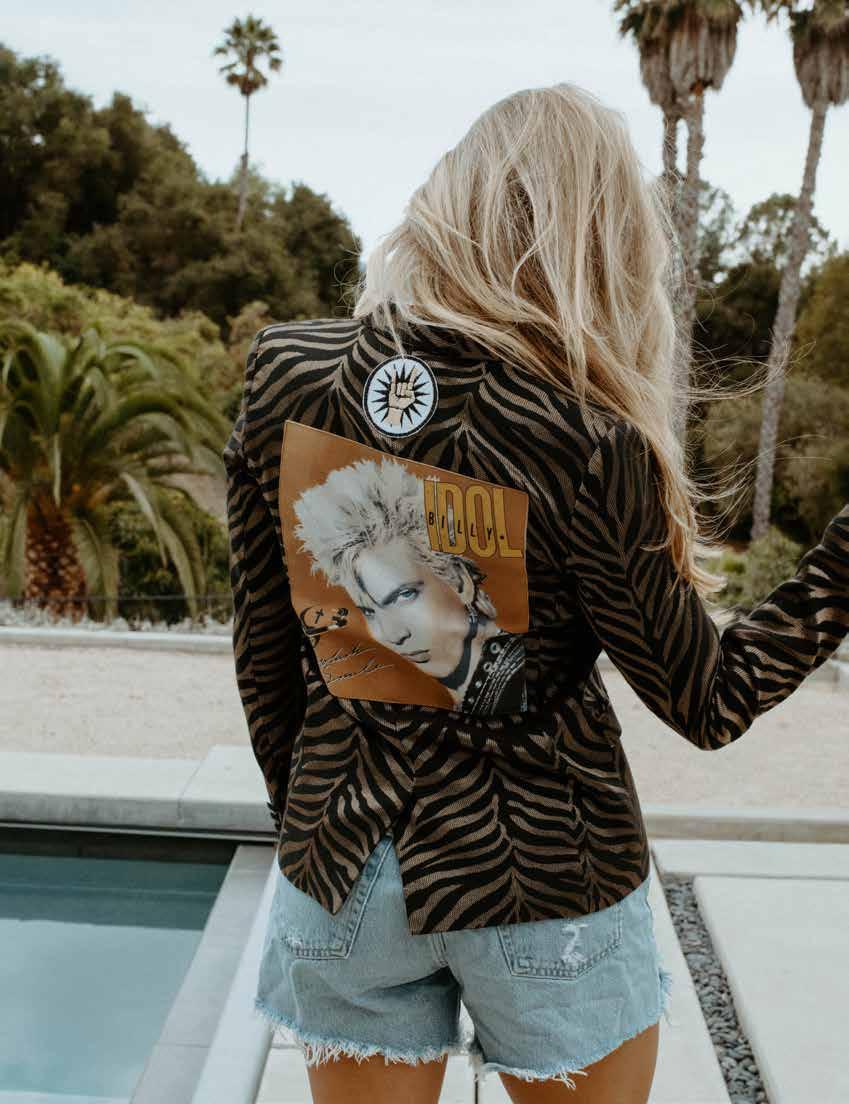
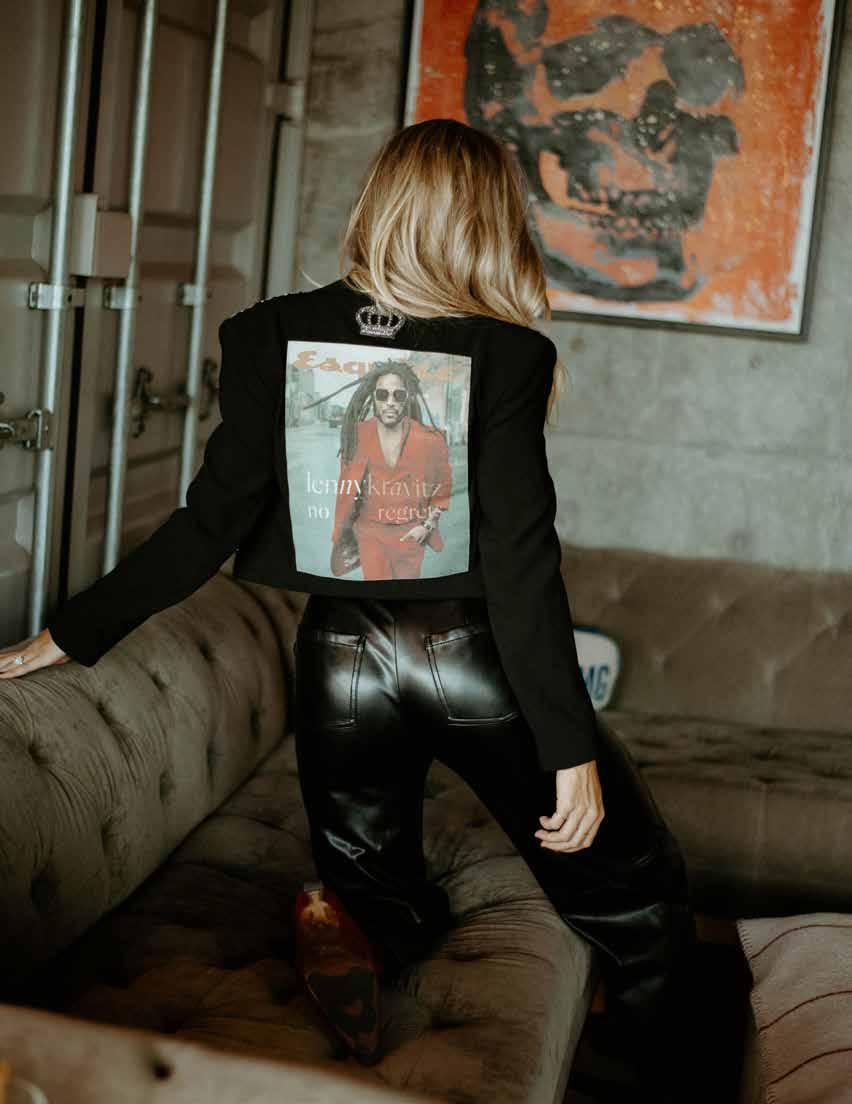
“Music is the great connector and I get the honor of bringing that love of music into my client’s lives one jacket at a time.”

Ina world obsessed with fast fashion and fleeting trends, celebrity stylist Dani Stone is rewriting the rules, one jacket at a time.
Long celebrated for her red-carpet eye and impeccable taste, has channeled her lifelong love affair with music into Tribute Project, a one-of-akind couture line that fuses high fashion with the raw energy of rock and roll.
Stone’s journey began in Los Angeles in the 1980s, a time when the Sunset Strip was pulsing with hair bands, neon lights, and music that would define a generation. A self-proclaimed “super-fan” of Guns N’ Roses, she craved something more elevated than the usual concert tee. Her answer? A Balmain-inspired military blazer with “Rocket Queen” emblazoned across the back, an instant cult classic among friends and fellow music obsessives. From there, Tribute Project was born, evolving into a rock ’n’ roll dynasty in the making.


Each piece in Tribute Project’s collection is a labor of love, steeped in personal history and musical passion. Stone scours the world for rare patches and memorabilia, weaving them into jackets and flannels that carry the spirit of countless nights at legendary venues like The Whisky and The Troubadour. No two pieces are alike. As Stone explains, “It starts with a conversation and a level of trust. The pieces are as individual as the music lovers who rock them.”
Lyrics are hand-stitched into linings. Vintage patches find new life on couture silhouettes. The result? Wearable art that is as exclusive as it is expressive, fashion that doesn’t just make a statement but tells a story.
Tribute Project’s clients aren’t just fashion enthusiasts; they’re collectors of moments, music lovers who see clothing as an extension of their personal soundtrack. In a fast-fashion era, Stone offers something rare: garments meant to last,

“The pieces are a true labor of love and as individual as the music lovers who rock them”

to be treasured, to headline your wardrobe like a chart-topping single.
Her pandemic-era shift into glam-grunge flannels expanded the line, infusing the same rock-driven ethos into a more relaxed vibe. Each creation continues to carry her trademark sense of style, honed over years of dressing Hollywood’s elite and appearing in the pages of fashion’s most influential magazines.
“Music is the great connector,” Stone says. “And I get the honor of bringing that love of music into each design one jacket at a time.”
For now, Tribute Project’s custom couture is available exclusively at Aria in Las Vegas and through her website.
Unlike typical online shopping, the site is intentionally non-shoppable, because every item is one-of-a-kind. Fans can browse her highlight reels on Instagram for the latest creations or commission a custom design.


And while Stone hints at future pop-ups at galleries and high-end retailers in major cities, the real magic is in the exclusivity: each jacket, each flannel, each design is a piece of personal music history you can wear.
For Dani Stone, Tribute Project isn’t just a brand, it’s a legacy stitched in passion, music, and the art of standing out.
tributeproject.com
Instagram: @tribute.project


R13 Crossover asymmetric distressed high-rise wide-leg jeans
$495

ZIMMERMANN
Hypnotic leather biker jacket
$2,250


GIANVITO ROSSI
85 metallic leather-trimmed suede ankle boots, $1595

+ Erin Wasson The Sud squareframe marbled acetate sunglasses
$895
FOUNDER, EDITOR IN CHIEF Twitter: @cecewoodsmedia Instagram: @cecewoods

NILI LOTAN Nessa cheetah-print cashmere tank $490

Dionysus debossed suede shoulder bag
$3,650


Three weeks before 9/11, Ryan Sawtelle landed in Hollywood chasing a dream of comedic acting, armed with little more than raw ambition and a sagging air mattress.
Then the world changed. A call from a friend back east, “The country is under attack”, sent him wandering down Sunset Boulevard into the old All American Burger, where he joined a room full of strangers locked in silence as the Twin Towers crumbled on the TV.
In a city where eye contact is rare and conversation rarer, something extraordinary happened: people began talking, connecting, holding onto each other in the chaos. That fleeting unity—later dubbed by Chris Pratt as “The 9/11 Effect”, branded itself into Sawtelle’s psyche, setting him on a path he never expected.
What started as a Hollywood hustle evolved into something far greater.
In 2008, Sawtelle planted Wave of Flags on the hillsides of Pepperdine, a stunning tribute of thousands of flags to honor lives lost on 9/11. The tribute gave rise to Ride to the Flags, a roaring display of patriotism that brought bikers, veterans, and civilians together in a force of unity and remembrance. By 2011, Sawtelle transformed that movement into the White Heart Foundation, where, as founder and executive director, he carved out a mission not just to honor, but to heal. White Heart doesn’t settle for vague gestures, it goes straight to the heart of the matter, funding mental health support for veterans and first responders carrying invisible scars. His Hollywood story may have begun with a dream of laughter, but what he’s built instead is a legacy of resilience, grit, and purpose.
Read more about Ryan Sawtelle’s journey in the new issue of Cali Mag.




Healing our nation’s heroes through nature, connection and community.


Aaron T. Jones doesn’t do “I told you so”, but if he did, Malibu would be at the top of his list.
Long before the Palisades Fire scorched its way into Southern California’s latest disaster headline, Jones, the CEO of International Protective Service, Inc. (IPS), and founder of the company’s elite Aviation Division, was waving red flags, and offering solutions – solutions that could have saved lives – and properties.
The problem? Local Malibu officials weren’t listening.
“They didn’t think lightning would strike twice—but it did,” Jones said, referring to the community’s blind eye to wildfire readiness – and he’s not exaggerating.
Since the 2018 Woolsey Fire, which torched nearly 100,000 acres, destroyed 1,600 structures, and forced the evacuation of over 295,000 residents, wildfire activity across Southern California hasn’t just increased - it’s exploded.
According to CalFire, the region has seen a 30% rise in annual wildfires and a 47% spike in “mega fires” - those that burn over 10,000 acres - since 2018. Add to that the fact that peak fire season now stretches nearly six months, and you’ve got a disaster forecast that reads more like a guarantee than a threat.


And yet—local leaders still treat each fire like a fluke. Jones, whose company operates a private air force more advanced than most government agencies, personally tried to get Malibu leadership to sit down and explore IPS’s fire detection and rapid response technology (the division is now known as AaroDyne Emergency Solutions LLC).
His fleet – Sikorsky S-76s, AS365s, AS350s, private jets, as well as drones loaded with FLIR and thermal imaging – was at the ready, fully capable of spotting flare-ups and deploying resources faster than L.A. County’s bureaucratic red tape.
But instead of partnering with a seasoned operator who’s built a global reputation protecting presidents, billionaires, and high-risk zones, Malibu’s leadership brushed him off – too busy putting out political fires at City Hall, knee-deep in scandals, petty power plays, and chaos triggered by disgruntled staffers. They ignored the guy with the drones and helicopters in the sky, and wildfire intel at his fingertips. Then reality hit harder than the flames—the Palisade fire was burning its way through Malibu, and suddenly everyone who ignored Jones started dialing his number like he was 911.
“They didn’t think lightning would strike twicebut it did”
The Palisades Fire of January 2025 didn’t just burn—it obliterated. In a matter of days, it torched over 23,400 acres, leveled 6,837 structures, and claimed 12 lives, making it one of the most catastrophic wildfires in Los Angeles County history. It didn’t just match the devastation of 2018’s Woolsey Fire - it blew past it. Woolsey scorched more land, but Palisades left behind a higher body count and a staggering trail of structural annihilation.
This wasn’t just a fire, it was yet again, another wake-up call in flames. And it proved, once again, that the region isn’t just at risk - it’s under siege.
Aaron T. Jones didn’t wait for permission, a press release – or even a headline – he just launched IPS Aviation and got to work.
While government agencies tripped over red tape and held press conferences, Jones was ready to put eyes in the sky, with wildfire cameras rolling 24/7, satellite overlays dialed in, and boots-in-theair ready to move before officials even finished their talking points.


His aircraft weren’t sitting pretty – they were locked, loaded, and ready to deliver critical intel in seconds while the rest of the system was still fumbling for a game plan.
At the helm is veteran pilot Denis Oliver, overseeing a Southern California-based air ops center outfitted with top-tier tech most emergency agencies only wish they had. FLIR systems. Thermal imaging. Rapid-response deployment. All ready, all operational.
This is what happens when a cop-turned-CEO plays the long game – and plays to win.
“Officials acted like Woolsey was a one-time thing,” Jones said. “Now they’re paying the price for being reactive instead of proactive.”
In May 2024, Aaron T. Jones didn’t just attend Malibu’s State of the City – he sponsored it. And he didn’t come empty-handed. He rolled out IPS Aviation’s cutting-edge wildfire detection fleet in front of a power-packed room that included State Senator Ben Allen, Assembly member Jacqui Irwin, and reps from Supervisor Lindsey Horvath’s office. Malibu city officials were all there, front and center, nodding politely as Jones laid out a clear, no-nonsense wildfire response plan.

The Palisade Fire, view from Malibu, January 7th, 2025.
January 7th, 2025.


Jones at Malibu State of the City on May 10th, 2024 introducing his new aviation division and wildfire prevention services.

Thermal imaging. Real-time surveillance. Rapid aerial deployment. It was all there – ready to activate.
And what did Malibu’s leadership do?
Nothing.
Despite being handed a fully operational solution on a silver platter, the city chose business as usual. More committees. More posturing. Zero action.
“They clapped, they smiled—and then they ghosted,” Jones later said.“Meanwhile, we were already airborne negotiating with a neighboring county to supplement emergency response.”
Jones - joined by respected leaders and fire-scarred residents - offered Malibu Mayor Doug Stewart a front-row seat to the future of wildfire prevention: a private jet ride, an elite tour of IPS Aviation HQ, and a firsthand look at life-saving tech. Stewart didn’t just decline - he ignored it entirely.
When it comes to public safety, Malibu’s mayor is missing in action.

Six months later, boom - the Palisades Fire exploded, turning warnings into wildfire, and silence into chaos.
Jones warned them. In public. On the record.
They didn’t think lightning would strike twice. It did. And this time, they can’t say they weren’t warned.
Aaron T. Jones had the tools. He had the tech. He had the track record.

Malibu had the warning. And now, they have the smoke.
“This isn’t about politics. It’s about public safety. And if you’re in a leadership position, you better start leading - or step aside.”
“When it comes to public safety, Malibu’s Mayor was missing in action.”
If you want to stop hearing “I told you so,” start listening to the people who know what the hell they’re doing.
Luckily for the rest of us, Jones’s IPS Global and IPS Aviation Division are still on the ground and in the air, proving what leadership actually looks like – that mission is rapidly expanding to include new government partnerships.
And under Jones’ watch, that mission keeps expanding including new government partnerships.
From cop to power player, Aaron T. Jones is redefining security, leadership—and what it means to give a damn.
Jones isn’t your average CEO. He’s the bulletproof blend of law enforcement grit, private sector muscle, and unapologetic authenticity.

LEFT: Dzyne Technologies, “Ultra” 86-foot fixed-wing drone engineered for endurance and precision with a flight ceiling of 25,000 feet and a top speed of 100 mph. The drone can remain airborne for 40 hours straight, delivering unmatched aerial surveillance and rapid deployment capabilities. FAR RIGHT: The Sikorsky S-76 is a twin-engine, medium-lift utility helicopter trusted by militaries, governments, and private operators worldwide.


LEFT: Built by Dzyne Technologies, the Ultra is an 86-foot fixed-wing drone engineered for endurance and precision. With a flight ceiling of 25,000 feet and a top speed of 100 mph, it can remain airborne for 40 hours straight—delivering unmatched aerial surveillance and rapid deployment capabilities. This isn’t just a drone. It’s a force multiplier. IPS Aviation is the domestic distributor for Dzyne Technologies.
FAR RIGHT: The XX832 SEPECAT Jaguar (far right) is a rare, decommissioned nuclear-capable fighter-bomber. It’s now being repurposed to support wildfire response efforts, equipped to deliver water, fire retardant, and other critical payload systems.


Now, through his Aaron Unplugged podcast, he’s also calling out the systemic failures—naming names and breaking down how political incompetence gets people hurt.
Jones cut his teeth in the ’90s under Beverly Hills PD royalty, working high-level protection details for foreign royalty and top-tier clients. That boots-on-the-ground experience fueled the launch of IPS in 2006, now a multi-state powerhouse offering armed patrol, tactical training, cyber security, and executive protection with a side of no-BS efficiency.
And if you thought Jones would stay quiet? Think again. His hit podcast Aaron Unplugged:Beyond the Shield just launched ripping the curtain back on everything from law enforcement corruption to leadership dysfunction.
“This show isn’t about politics, it’s about truth. And sometimes, truth punches harder than any headline.”said Jones.
“This show isn’t about politics, it’s about truth. And sometimes, truth punches harder than any headline.”said Jones.
Jones is the man who sees leadership where others see liability. The guy who shows up when sirens fade. The voice in a world of silence.
As a result of the powerful contribution to wildfire preparedness IPS Aviation can offer, Jones was also asked to make an appearance on a documentary about the Palisades Fire along with former Sheriff Alex Villanueva.
Whether he’s behind the mic – or a camera – wearing the badge, or stepping out of a bulletproof vest, Aaron T. Jones isn’t just in the room. He is the response.
And when the stakes are high?
You’re either standing with him - or standing in his way.
Website: aarontjones.us


